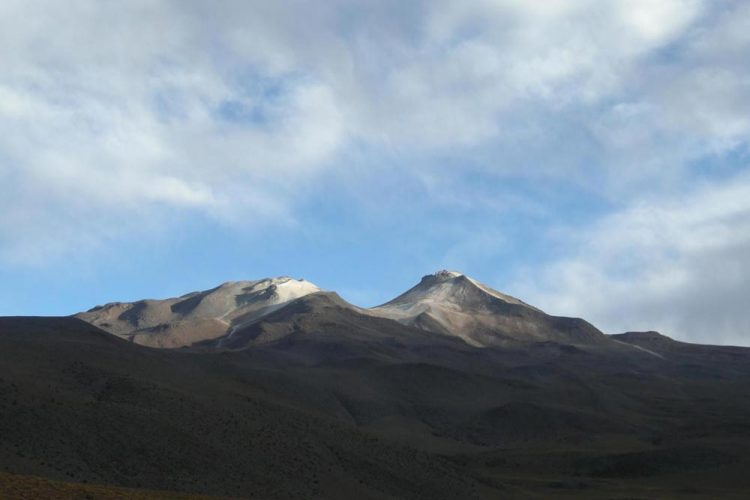Massive 'lake' discovered under volcano that could unlock why and how volcanoes erupt

Cerro Uturuncu volcano in the Bolivian Altiplano. Credit: Jon Blundy - University of Bristol
The body of water – which is dissolved into partially molten rock at a temperature of almost 1,000 degrees Celsius – is the equivalent to what is found in some of the world's giant freshwater lakes, such as Lake Superior.
The find has now led scientists to consider if similar bodies of water may be 'hiding' under other volcanoes and could help explain why and how volcanoes erupt.
Professor Jon Blundy, from the School of Earth Sciences, took part in an international multidisciplinary research project at Cerro Uturuncu volcano in the Bolivian Altiplano.
He said: “The Bolivian Altiplano has been the site of extensive volcanism over past 10 million years, although there are no currently active volcanoes there.
“The Altiplano is underlain by a large geophysical anomaly at depths of 15 km below the surface of the earth.
“This anomaly has a volume of one-and-a-half million cubic kilometres or more and is characterised by reduced seismic wave speeds and increased electrical conductivity. This indicates the presence of molten rock.
“The rock is not fully molten, but partially molten. Only about 10 to 20 percent of the rock is actually liquid; the rest is solid. The rock at these depths is at a temperature of about 970°C.”
In order to characterise the partially molten region the team performed high temperature and pressure experiments at the University of Orléans in France.
This measured the electrical conductivity of the molten rock in the 'anomalous' region and concluded that there must be about eight to ten percent of water dissolved in the silicate melt.
Professor Blundy added: “This is a large value. It agrees with estimates made for the volcanic rocks of Uturuncu using high temperature and pressure experiments to match the chemical composition of crystals.
“Silicate melt can only dissolve water at high pressure; at lower pressure this water comes out of the solution and forms bubbles. Crucially – these bubbles can drive volcanic eruptions.
“The eight to ten percent of water dissolved in the massive anomaly region amounts to a total mass of water equivalent to what is found in some of the giant freshwater lakes of North America.”
Professor Fabrice Gaillard at University of Orléans explained: “Ten per cent by weight of dissolved water means that there is one molecule of water for every three molecules of silicate. This is an extraordinarily large fraction of water, helping to explain why these silicate liquids are so electrically conductive.”
The researchers hope that better understanding of how water can trigger volcanic eruptions can improve predictions of when it is going to erupt.
Media Contact
All latest news from the category: Earth Sciences
Earth Sciences (also referred to as Geosciences), which deals with basic issues surrounding our planet, plays a vital role in the area of energy and raw materials supply.
Earth Sciences comprises subjects such as geology, geography, geological informatics, paleontology, mineralogy, petrography, crystallography, geophysics, geodesy, glaciology, cartography, photogrammetry, meteorology and seismology, early-warning systems, earthquake research and polar research.
Newest articles

High-energy-density aqueous battery based on halogen multi-electron transfer
Traditional non-aqueous lithium-ion batteries have a high energy density, but their safety is compromised due to the flammable organic electrolytes they utilize. Aqueous batteries use water as the solvent for…

First-ever combined heart pump and pig kidney transplant
…gives new hope to patient with terminal illness. Surgeons at NYU Langone Health performed the first-ever combined mechanical heart pump and gene-edited pig kidney transplant surgery in a 54-year-old woman…

Biophysics: Testing how well biomarkers work
LMU researchers have developed a method to determine how reliably target proteins can be labeled using super-resolution fluorescence microscopy. Modern microscopy techniques make it possible to examine the inner workings…





















